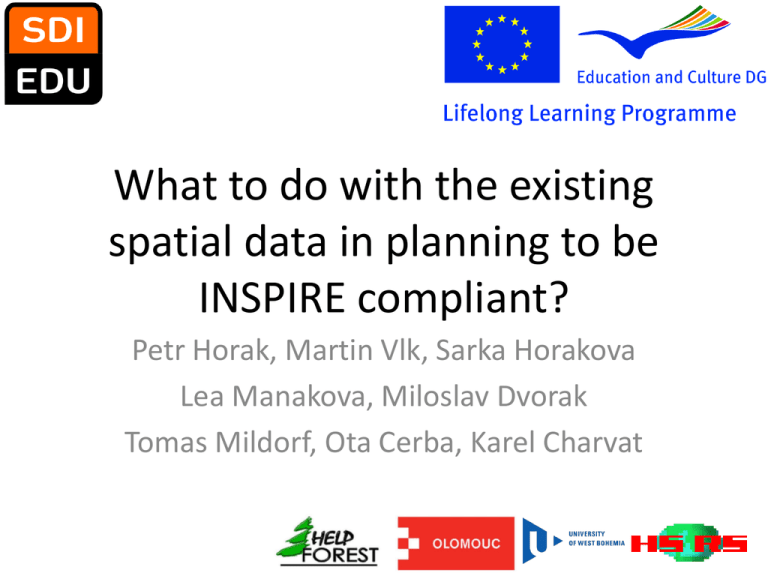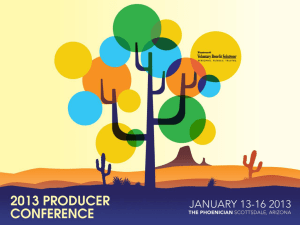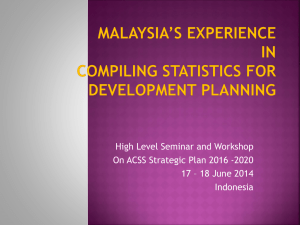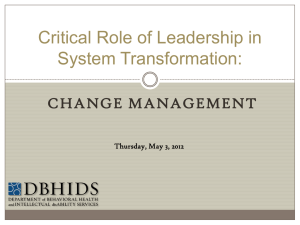Plan4all Data Model
advertisement

What to do with the existing spatial data in planning to be INSPIRE compliant? Petr Horak, Martin Vlk, Sarka Horakova Lea Manakova, Miloslav Dvorak Tomas Mildorf, Ota Cerba, Karel Charvat Role of Spatial Planning Spatial planning acts between all levels of government so planners face important challenges in the development of territorial frameworks and concepts every day. Spatial planning systems, the legal situation and spatial planning data management are completely different and fragmented throughout Europe. Nevertheless, planning is a holistic activity. All tasks and processes must be solved comprehensively with input from various sources. It is necessary to make inputs interoperable because it allows the user to search data from different sources, view them, download them and use them with help of geoinformation technologies (GIT). Plan4all Data Model Plan4all develops conceptual data models for seven selected themes from Annexe II and III of the INSPIRE Directive. The themes are land cover, land use, utility and government services, production and industrial facilities, agriculture and aquaculture facilities, area management/restriction/regulation zones and reporting units, and natural risk zones. The data models refer to the INSPIRE documents „Generic Conceptual Model (GCM)“ and „Methodology for the development of data specifications“ which set basic rules for the development of data models. Plan4all Data Model The object-oriented Plan4all data models are flexible enough to be extended easily with further objects. Each object has a unique identity which is immutable and used only once, even if an object is removed its identity is not assigned to other objects. Also code lists and nomenclatures are extendable. To specify the models in diagrams UML is used. The data models are published on the Plan4all website and are open for validation by affiliated partners. Further, the Plan4all data models was an input for the development of the INSPIRE data models by the INSPIRE thematic working groups. Especially, there is strong cooperation concerning the land use theme. INSPIRE Spatial Data Themes •Annex II •Elevation •Land cover •Orthoimagery •Geology Plan4all Annex I •Coordinate reference system •Geographical grid systems •Geographical names •Administrative units •Addresses •Cadastral parcels •Transport networks •Hydrography •Protected sites Annex III •Statistical units •Buildings •Soil •Land use •Human health and safety •Utility and Government services •Environmental monitoring facilities •Production and industrial facilities •Agricultural and aquaculture facilities •Population distribution – demography •Area management/restriction/regulation zones and reporting units •Natural risk zones •Atmospheric conditions •Meteorological geographical features •Oceanographic geographical features •Sea regions •Bio-geographical regions •Habitats and biotopes •Species distribution •Energy resources •Mineral resources Plan4all Outputs 1. Promotion 2. Metadata profiles 3. Data models • Land cover • Land use • Utility and Government services • Production and industrial facilities • Agricultural and aquaculture facilities • Area management/restriction/regulation zones and reporting units • Natural risk zones 4. Networking architecture 5. Validation 6. Geoportal 7. Data and metadata deployment Plan4all Harmonisation Idea Conceptual model Source Data HF Source Data MEDDTL Source Data OLOMOUC Source Data LAZIO Source Data TDF Source Data LGV Source Data ZPR Source Data ADR Target Data Structure Source Data EPF Source Data DIPSU Source Data PROVROMA Source Data AVINET Source Data FTZ Source Data GEORAMA Source Data MAC Source Data NASURSA Source Data GIJON Plan4all Harmonisation Idea Source Data Transformation Source Data HF Number Name_area Number_area LandUse_code LandUse_descr …… Source Data Olomouc Level Layer PLFEST GLUF MACRO …… Plan4all Land Use model Target Data Structure InspireID Status RegulationNature IsOverlayArea Geometry Property LUCAs_Code MacroClassificationOfL and GeneralLandUseType SpecificLandUseType …… Harmonised data Harmonization steps 1. Description of the source data structure – the exact description of the source data enables better understanding of data and definition of the transformation table. The description includes a scheme of data structure, description of data formats, object types and Code lists or enumerations. 2. Data transformation – it is a main harmonisation process where data from the original source structure is transformed into the target structure. The target data structure is created on the basis of conceptual models. The transformation has two levels – at first, the transformation of features has to be specified and then also transformation of code lists or enumerations must be defined for each transformed attribute. The transformation can be done through transformation tools or directly through SQL query. 3. Publication – there are several ways how to publish the harmonised data stored in the target structure. The Plan4all regions test the publication of the harmonised spatial planning data in their own web map applications and also provided the data through OGC web services WMS and WFS. Source Data Description Description of the source data - General principle of the data management in regions - Description of structures of the source data (relations, objects, features, code lists) - Translation of national terms Data Transformation Transformation methodes 1. Transformation tools 2. Direct editing of database - SQL queries (used in Sumperk and Olomouc) Data transformation process (HF example) • • • The target structure has been established on the basis of LandUse conceptual data model defined in WP4. Because this conceptual data model is not fully corresponding to the source data structure, some modifications have been proposed and only some of the fields have been used. The target database is PostGIS. The transformation (harmonisation) scheme have been defined in two steps • The scheme for attributes transformation • The scheme for values transformation – comparison of enumerations of the source and target data The target PostGIS tables have been filled on the basis of transformation (harmonisation) schemes Data Transformation Transformation schemes 1. Features transformation 2. Attributes transformation Data Transformation An example of the multi-level transformation of attributes Target Sources Publication Publication of Harmonised Data via Geohosting tool • Web Map Client • OGC Web Services (WMS, WFS) Agreement on: • Coordination system and projection: ETSR (EPSG 3035) • Legends for Land Use data presentation Publication Map Compositions via Geohosting tool Publication in Web Map Client Original data Harmonised General Land Use Harmonised Status of Area WMS Compositions Examples of Harmonised Data Building Percentage in developing areas Height indication Examples of Harmonised Data Specific LandUse Type Indirect Executions Connection to INSPIRE The Plan4all project has been invited to participate in the testing of the INSPIRE Annex II and III data specifications. Plan4all joined to the INSPIRE testing team. Within the Plan4all wil be tested the INSPIRE themes: - Land Cover - Land Use - Natural Risk Zones Plan4all conceptual data models will be replaced by INSPIRE data specifications => the present experience with tests on conceptual models will be re-used in following INSPIRE tests Message to LandUse Testers • To better understand source-target relations a precise definition of the source data should be created and described. There does not exist any fixed standard for planning data in many countries and the definition should help to harmonise the different data in the same way. • Define precise specific code lists and enumerations with explanation of terms. The same values may imply different meaning to people from different countries and consequently harmonised datasets may be technically correct, but are not in reality. This is not problem of the data model, but a consequence of differences in spatial planning in European countries. • Be aware of the potential multiplicity of Harmonised attributes • Define names of the source and target elements of the association connectors. Otherwise it is very difficult to identity these associations in schema mapping tools. Message to LandUse Testers • If you propose changes of the models try to get the model as simple as possible. • Specify precise metadata fields and leave them out of the data as much as possible – of course, where it is useful ! • Define symbols and colour presentation for harmonised data. • Include an information sheet explaining the difficulties experienced in aligning and aggregating the data across the local and regional areas and then up to the national and supernational levels. The different professions, software and methodologies used in the countries are too great to compile into one document, however drafting such a sheet allows policy and decision makers to understand the hurdles yet facing spatial information. • Be aware of problems with overlaying features. Integration of data • Transformed data could be integrate with global Land use models like: • CLC • Urban Atlas CLC 2006 of Czech Republic CLC 2006 of Czech Republic Overlapping with Urban Atlas Overlapping with Urban Atlas General LanUse Metadata Import Metadata Import Discovery Metadata Import Visualization Visualization








